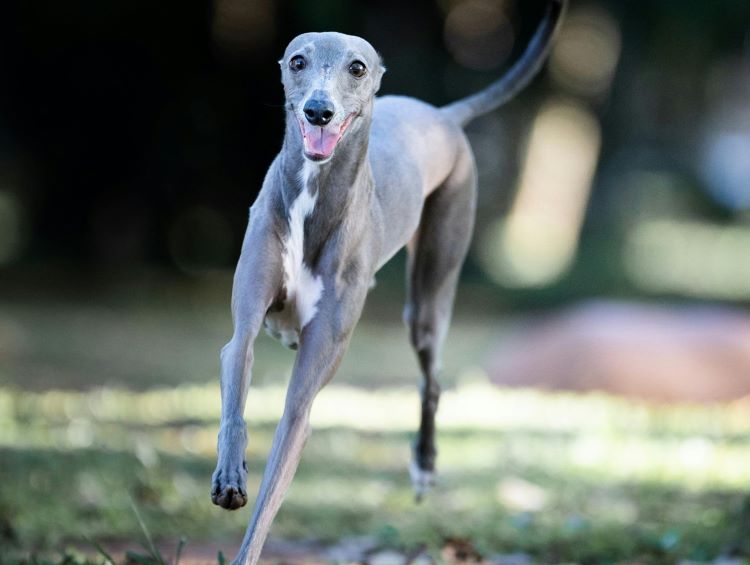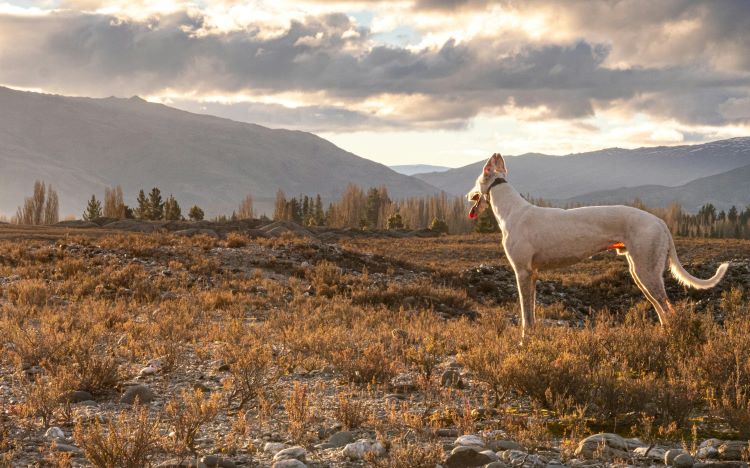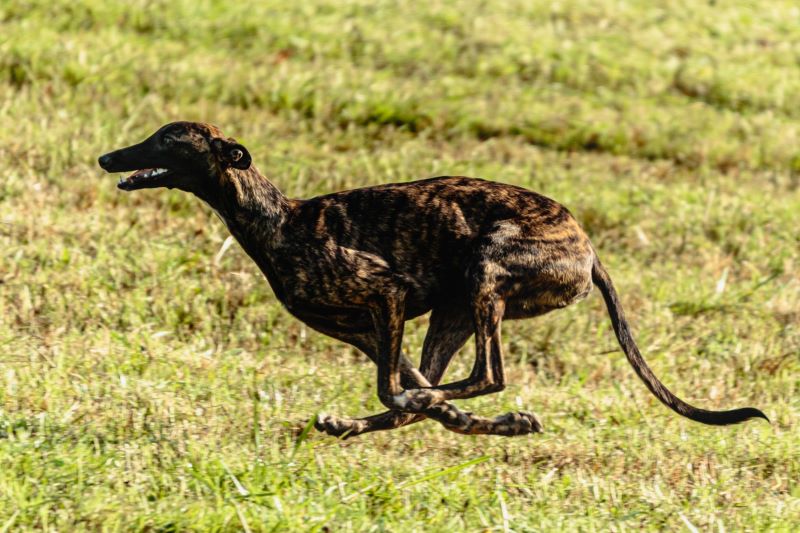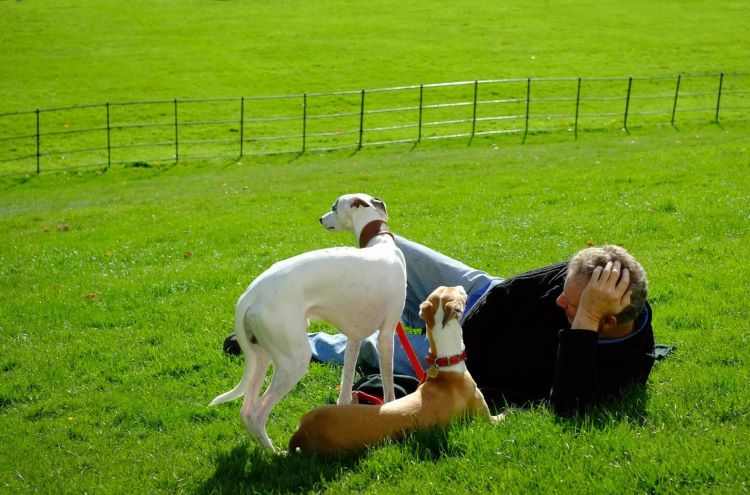Ready to help treat your pet to a healthy life?
Adopt-a-Greyhound Month: 10 Fun Facts About the Breed
By : Brianna Gunter | Updated Apr 10, 2025

Did you know there's a special time of year just for Greyhounds? It's true! April is National Greyhound Adoption Month, also known as Adopt-a-Greyhound Month. Started in 2010 by The Greyhound Project, this month is dedicated to finding homes for Greyhounds in shelters and promoting the welfare of former racing dogs. It’s also a great time of year for appreciating all that this unique canine breed has to offer.
Why does National Greyhound Adoption Month exist?
Greyhound racing is synonymous with dog racing, a sport and gambling activity that involves the dogs running against each other around an enclosed track (typically pursuing a mechanical rabbit). It is also considered controversial, especially when it comes to the treatment and well-being of the canines involved.
Greyhounds are typically between two and five years old when their racing days end, after which they are sent to shelters and adoption programs. It’s unclear how many go on to be adopted by families, as the organizations that run Greyhound racing in North America only keep track of active dogs. However, adult dogs are less likely to be adopted than puppies.
Prospective pet owners may also be unsure of taking in a former race dog without having any prior experience with them. National Greyhound Month is intended to help ease concerns by spreading awareness and education.
Greyhound racing laws
In the United States, Greyhound racing remains legal at the federal level, though a bill called the Greyhound Protection Act was introduced in 2023 (it has yet to be passed and has since been referred to different committees). Nevertheless, Greyhound racing is not broadly practiced. As of 2025, Greyhound races only remain legal in 8 states: Alabama, Arkansas, Connecticut, Iowa, Kansas, Oregon, West Virginia and Wisconsin. Though seasonal and ad-hoc races can happen in any of these states (Abilene, Kansas hosts spring and fall nationals, for example) only two dedicated dog racing tracks actually remain open in the entire country, both in West Virginia. While the National Greyhound Association sets strict dog care rules that tracks must abide by, the living and treatment conditions can vary depending on local policies.
In Canada, Greyhound racing is still technically legal, but it is unregulated.

12 fun facts about Greyhounds
The English greyhound, or simply greyhound, is an easily recognizable dog breed with its narrow face and long, lean body built for running. But there’s so much more about these dogs than meets the eye. Ready to get your dog trivia on? Let’s learn some awesome facts about Greyhounds!
1. They’re not always ‘grey’
Despite their name, Greyhounds are not always gray in color. In fact, they’re often not! According to American Kennel Club (AKC) Greyhound breed standards, the dog’s short, smooth coat can come in almost any hue. In addition to solid shades of gray (also called “blue”), brown, black, and white, greyhounds have been observed in a variety of patterns, including tri-colored, brindle, and even spotted.
2. Greyhounds have great eyesight
The Greyhound is part of a bigger family of dogs known as “sighthounds” or “gazehounds.” This group of hunting dogs is characterized by long, slender legs and thin bodies. Perhaps most notable of all is their advanced sight (hence the name), which gives them the ability to spot small movements across long distances. Unlike other dog breeds that are naturally driven to hunt by scent and energy endurance, sighthounds are driven by their vision and speed.
3. Nobody knows why Greyhounds are called 'Greyhounds'
The breed dates back thousands of years, and there is no clear record as to how it got its name. However, there are several dominating theories. The first is that the name is simply a mispronunciation of “gazehound” that became widespread over time. The second is that the dogs first came to England from Greece, prompting the name “Greekhounds,” which then morphed into “Greyhounds.”
Others believe the term is derived from the Old English “grighund,” which in turn stems from an Old Norse term for a female dog. Finally, there’s also the literal theory behind the name: most early Greyhounds may have been mostly gray in color.
4. They’re one of the oldest dog breeds
Archaeological discoveries date the Greyhound back at least 4,000 years, although cave paintings of what appears to be a similar breed could mean the dog is closer to 8,000 years old. The Greyhound is therefore widely accepted as one of the oldest purebred dog breeds in existence today.
5. Greyhounds run like cheetahs
Greyhounds are known for their “double suspension gallop” running style, which coincidentally is what nature’s fastest cat is also known for. Greyhounds and cheetahs also have similar streamlined body builds, complete with a deep chest and lengthy legs. Cheetahs are still faster with top speeds at 65 mph compared to the Greyhound’s 45 mph according to Smithsonian Magazine, though scientists are unsure why.

6. They’re one of the sleepiest dog breeds
Greyhounds may be known as the world's fastest dog breed, but they're also one of the sleepiest. If your greyhound spends the bulk of his day sleeping, that’s perfectly normal. Greyhounds snooze between 16 and 18 hours a day, compared to the average dog’s 10 to 12 hours. Active racing dogs, greyhound puppies, and elderly Greyhounds are likely to catch even more Z’s and may get upwards of 20 hours of sleep in a single 24-hour time period.
7. Greyhounds may be an allergy-friendly choice
While not considered 100% hypoallergenic, greyhounds have very little to no undercoat and shed minimally throughout the year. They also don’t produce the high levels of pet dander than many other dog breeds do, making them a manageable canine friend for people with mild-to-medium allergies. A Greyhound’s coat is also very easy for pet owners to maintain.
8. They avoid conflict
Greyhounds are usually not aggressive dogs, and they actually tend to avoid conflict whenever possible. Instead of snarling or growling when feeling upset or defensive, Greyhounds are known for either freezing in place or trying to slink away. Their docile behavior makes greyhounds good pets for families with young children.
9. They’re one quiet dog breed
In addition to avoiding aggressive behavior, greyhounds tend to be quiet when it comes to general expression. One of the few hound-type dogs that can be considered quiet, the Greyhound’s relative silence is believed to be a combination of its laid-back demeanor as well as its love of sleep.
10. Greyhounds love to cuddle
While their leggy, often bony-looking appearances don’t exactly scream “let’s cuddle!” most Greyhounds enjoy doing exactly that. Frequently named among the top 10 cuddliest dog breeds, greyhounds love to snooze near their humans. Their lack of body fat also means they seek out soft, warm surfaces to get cozy and avoid getting too cold.
11. They have long lifespans
Large dog breeds are typically associated with shorter lifespans thanks to centuries of selective breeding (and also possibly due to their organs having to work harder to accommodate their size). However, the Greyhound is known for having an unusually long lifespan for its size, averaging between 10 and 14 years. For comparison, the average lifespan of a large dog (pups that weigh between 50 and 90 lbs. or 23 to 41 kg. or more when fully grown), is generally between 8 and 14 years.
12. They're a staple of pop culture
The Greyhound breed has long been a symbol of grace and athleticism, and as such it's made numerous appearances in works of art and media. From ancient mythology to modern day TV shows like The Simpsons (fans will note that the show's first episode introduced Santa's Little Helper, a former racing Greyhound), these dogs have made their mark in human society well beyond the racetrack.

How to celebrate Greyhound Adoption Month
There are a variety of ways to celebrate this month honoring greyhounds. You can support greyhound adoption and rescue organizations by making donations, sponsoring a dog, or volunteering at a shelter or fundraiser.
Obviously, one of the best ways to celebrate National Adopt-a-Greyhound Month is to welcome one of these exceptional dogs into your home. But before you make any decisions, be sure to do more in-depth research and make sure you’re equipped to give a greyhound the love and care it needs. Even though these dogs love sleeping, for example, they still need at least an hour of exercise every day.
Like all dogs, greyhounds also require routine veterinary care. Adult dogs need exams at least once a year, while puppies and dogs with certain health conditions will require veterinary appointments more frequently. You’ll also want to protect your greyhound’s health from the unexpected by enrolling them in dog insurance. Learn more about how Trupanion can help your pet today.
